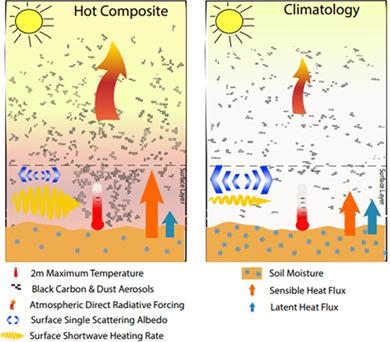当前位置:
X-MOL 学术
›
Int. J. Climatol.
›
论文详情
Our official English website, www.x-mol.net, welcomes your
feedback! (Note: you will need to create a separate account there.)
Absorbing aerosols and high‐temperature extremes in India: A general circulation modelling study
International Journal of Climatology ( IF 3.5 ) Pub Date : 2020-08-02 , DOI: 10.1002/joc.6783 Arpita Mondal 1, 2 , Neeraj Sah 1 , Arushi Sharma 2 , Chandra Venkataraman 2, 3 , Nitin Patil 2
International Journal of Climatology ( IF 3.5 ) Pub Date : 2020-08-02 , DOI: 10.1002/joc.6783 Arpita Mondal 1, 2 , Neeraj Sah 1 , Arushi Sharma 2 , Chandra Venkataraman 2, 3 , Nitin Patil 2
Affiliation

|
Heat waves in India during the pre‐monsoon months have significant impacts on human health, productivity and mortality. While greenhouse gas‐induced global warming is believed to accentuate high temperature extremes, anthropogenic aerosols predominantly constituted by radiation‐scattering sulfate are believed to cause an overall cooling in most world regions. However, the Indian region is marked by an abundance of absorbing aerosols, such as black carbon (BC) and dust. The goal of this work was to understand the association between aerosols, particularly those that are absorbing in nature, and high‐temperature extremes in north‐central India during the pre‐monsoon season. We use 30‐year simulations from a chemistry‐coupled atmosphere‐only general circulation model (GCM), ECHAM6‐HAM2, forced with evolving aerosol emissions in an interactive aerosol module, along with observed evolving SSTs. A composite of high‐temperature extremes in the model simulations, compared to climatology, shows large‐scale conditions conducive to heat waves. Importantly, it reveals concurrent positive anomalies of BC and dust aerosol optical depths. Changes in near‐surface properties include a reduction in single scattering albedo (implying greater absorption) and enhancement in short‐wave heating rate, compared to climatological conditions. Alterations in surface energy balance include reduced latent heat flux, but increased sensible heat flux, consistent with enhanced temperatures. Thus, chemistry‐coupled GCM simulations capture an association of absorbing aerosols with high‐temperature extremes in north India, arising from radiative heating in the surface layer.
中文翻译:

印度吸收气溶胶和高温极端现象的一般循环模型研究
季风前几个月印度的热浪对人类健康,生产力和死亡率都有重大影响。尽管人们认为温室气体引起的全球变暖加剧了高温极端现象,但据认为主要由辐射散射硫酸盐构成的人为气溶胶在大多数世界区域引起整体降温。但是,印度地区的特征是大量吸收气溶胶,例如黑碳(BC)和粉尘。这项工作的目的是了解气溶胶,特别是自然界中吸收的气溶胶,与季风前季节在印度中北部的极端高温之间的关系。我们使用化学耦合的仅大气通用循环模型(GCM)ECHAM6-HAM2进行的30年模拟,在互动式气雾模块中伴随着不断发展的气溶胶排放,以及观察到的不断发展的SST。与气候学相比,模型模拟中的高温极端综合显示了有利于热波的大规模条件。重要的是,它揭示了同时存在的BC和粉尘气溶胶光学深度的正异常。与气候条件相比,近地表性质的变化包括单散射反照率的降低(意味着更大的吸收)和短波加热速率的提高。表面能平衡的变化包括潜热通量减少,但显热通量增加,与温度升高相一致。因此,化学耦合的GCM模拟获得了印度北部吸收气溶胶与高温极端的关联,
更新日期:2020-08-02
中文翻译:

印度吸收气溶胶和高温极端现象的一般循环模型研究
季风前几个月印度的热浪对人类健康,生产力和死亡率都有重大影响。尽管人们认为温室气体引起的全球变暖加剧了高温极端现象,但据认为主要由辐射散射硫酸盐构成的人为气溶胶在大多数世界区域引起整体降温。但是,印度地区的特征是大量吸收气溶胶,例如黑碳(BC)和粉尘。这项工作的目的是了解气溶胶,特别是自然界中吸收的气溶胶,与季风前季节在印度中北部的极端高温之间的关系。我们使用化学耦合的仅大气通用循环模型(GCM)ECHAM6-HAM2进行的30年模拟,在互动式气雾模块中伴随着不断发展的气溶胶排放,以及观察到的不断发展的SST。与气候学相比,模型模拟中的高温极端综合显示了有利于热波的大规模条件。重要的是,它揭示了同时存在的BC和粉尘气溶胶光学深度的正异常。与气候条件相比,近地表性质的变化包括单散射反照率的降低(意味着更大的吸收)和短波加热速率的提高。表面能平衡的变化包括潜热通量减少,但显热通量增加,与温度升高相一致。因此,化学耦合的GCM模拟获得了印度北部吸收气溶胶与高温极端的关联,











































 京公网安备 11010802027423号
京公网安备 11010802027423号